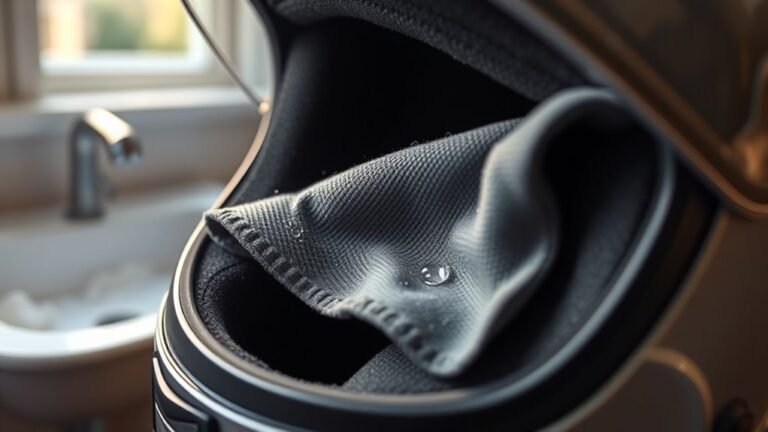Preventing Helmet-Related Neck Pain: Tips and Tricks
To prevent helmet-related neck pain, make sure your helmet fits snugly by measuring your head circumference accurately. Adjust straps and interior padding for a comfortable fit, distributing weight evenly. Strengthen your neck and shoulder muscles with exercises like chin tucks and shoulder shrugs. Take breaks every 30 to 60 minutes to perform neck rotations and stretches. Also, listen to your body’s signals for comfort. With these strategies, you can enhance your riding experience and discover further tips for lasting relief.
Understanding the Causes of Helmet-Related Neck Pain

When you’re wearing a helmet, it’s easy to overlook the strain it can place on your neck. The weight of the helmet directly impacts your posture alignment. Heavier helmets can create an imbalance, forcing your neck muscles to work harder to support the extra weight. This added strain can lead to discomfort or pain over time, especially if you’re not maintaining proper posture. If your head tilts forward or backward due to a poorly balanced helmet, it exacerbates the issue, leading to muscle fatigue and tension. Keeping your helmet light and properly aligned can help mitigate these risks. Always be mindful of how your gear interacts with your body, as ideal posture is essential for enjoying your activities without unnecessary discomfort.
Choosing the Right Helmet Fit

A proper helmet fit is essential for minimizing the risk of neck pain and ensuring overall safety. Start with accurate helmet sizing; measure your head circumference just above your eyebrows. Most manufacturers provide sizing charts to help you find the right fit. Once you’ve selected a helmet, conduct a comfort assessment. It should sit snugly without excessive pressure on your forehead or temples. The helmet should not move when you shake your head, indicating it’s secure. Pay attention to weight distribution; a well-fitted helmet should feel balanced and not strain your neck. Remember, a helmet that fits poorly can lead to discomfort and increased risk of injury, so take the time to choose wisely.
Adjusting Your Helmet for Maximum Comfort

Adjusting your helmet properly is essential for achieving maximum comfort and reducing neck strain. A well-fitted helmet distributes weight evenly, preventing pressure points that can lead to discomfort. You’ll also need to fine-tune the straps to secure the helmet without causing excessive tightness around your head.
Proper Fit Importance
Ensuring a proper helmet fit is essential for preventing discomfort and potential neck pain during rides. A well-fitted helmet not only enhances your safety but also improves your riding experience. Here are key steps for effective helmet adjustment and fit testing:
- Measure Your Head: Use a soft tape measure around the widest part of your head to find your size.
- Adjust the Interior Pads: Use removable pads to customize the fit, ensuring it hugs your head without being overly tight.
- Check the Retention System: Adjust the chin strap so it’s snug but comfortable, allowing you to fit one finger underneath.
- Test the Movement: Shake your head gently; the helmet should stay in place without excessive movement.
These steps can greatly reduce the risk of neck pain.
Strap Adjustment Techniques
While proper fit is essential, strap adjustment techniques play an important role in enhancing helmet comfort and preventing neck pain. Start by identifying the strap types your helmet features; most helmets use either standard buckles or magnetic closures. For standard buckles, make sure the straps lie flat against your cheeks and adjust the chin strap to sit snugly without pinching. With magnetic closures, simply pull the straps until they provide a comfortable fit. Remember to check the rear retention system, adjusting it for stability without causing pressure points. Regularly reassess your adjustments, especially after prolonged use. These simple techniques can greatly improve comfort, allowing you the freedom to enjoy your ride without the distraction of discomfort or pain.
Strengthening Neck and Shoulder Muscles
Strengthening your neck and shoulder muscles is essential for minimizing helmet-related neck pain, as these areas bear much of the weight and pressure from helmet use. Incorporating targeted neck exercises can promote muscle relaxation and enhance your strength. Here are four effective exercises to contemplate:
- Neck Tilts: Gently tilt your head side to side, holding each position for 15 seconds.
- Shoulder Shrugs: Raise your shoulders towards your ears, hold for a few seconds, then release.
- Chin Tucks: Pull your chin towards your chest to engage and strengthen neck muscles.
- Wall Angels: Stand against a wall and move your arms in a “W” to “Y” position, keeping your back flat.
Regular practice can considerably reduce discomfort and improve stability.
Taking Breaks and Stretching
Even with strong neck and shoulder muscles, prolonged helmet use can lead to discomfort if you don’t take regular breaks and stretch. Implementing a structured break frequency is vital for maintaining your comfort and freedom of movement. Aim to take a break every 30 to 60 minutes, allowing your muscles to relax and recover. During these breaks, utilize effective stretching techniques such as neck rotations, shoulder shrugs, and gentle side bends. These stretches can alleviate tension and improve blood circulation, reducing the risk of pain. Remember, listening to your body is important; if you start feeling discomfort, don’t hesitate to pause and stretch. Your neck and shoulders will thank you, enhancing your overall riding experience.
Exploring Alternative Helmet Designs
As you seek to minimize helmet-related neck pain, exploring alternative helmet designs can be an essential step. These innovative options often incorporate ergonomic shapes and materials that better distribute weight and reduce strain. Consider the following designs:
- Multi-layered helmets: Utilizing innovative materials for shock absorption can greatly lessen impact forces.
- Lightweight models: Helmets crafted from high-strength, lightweight composites can reduce neck load.
- Custom-fitted options: Tailored helmets molded to your head shape guarantee ideal comfort and support.
- Ventilated designs: Helmets with enhanced airflow can keep you cooler, promoting longer rides without discomfort.
Listening to Your Body and Adjusting Riding Habits
How well do you know your body’s signals while riding? Recognizing these signals is vital for preventing helmet-related neck pain. Pay attention to discomfort or stiffness in your neck; these are body signals that suggest your riding posture may need adjustment. Make certain your helmet fits correctly and isn’t too heavy, as this can strain your neck. Regularly reassess your riding habits—long periods in a fixed position can exacerbate discomfort. Incorporate breaks to stretch and reposition yourself, allowing your body to recover. Experiment with different riding postures, such as lowering your head slightly or adjusting handlebar height, to find what feels best. Listening to your body and making these adjustments can lead to a more enjoyable, pain-free riding experience.
Frequently Asked Questions
Can Neck Pain Occur From Wearing a Helmet Too Long?
Yes, neck pain can occur from wearing a helmet too long. The weight of the helmet can create pressure on your neck, similar to a heavy crown that weighs down a king. As you ride, this constant pressure may strain your muscles, leading to discomfort. To guarantee freedom while wearing your helmet, take breaks, adjust it for a better fit, and consider lighter models to reduce that relentless weight and pressure on your neck.
What Are the Signs of an Improperly Fitted Helmet?
If your helmet’s improperly fitted, you might notice discomfort, pressure points, or excessive movement when you shake your head. It shouldn’t pinch or slide around. Ideally, helmet sizing should allow for a snug fit without causing pain. Use adjustment techniques like padding or resizing to achieve that perfect fit. If you feel any restriction in movement, it’s a sign to reevaluate the fit for both safety and comfort.
How Does Weather Affect Helmet Comfort and Neck Pain?
Weather greatly impacts your helmet comfort and neck pain. Temperature fluctuations can cause discomfort; too hot or cold can lead to increased muscle tension. High humidity effects may result in sweating, making your helmet feel heavier and less stable, which can strain your neck. It’s essential to adjust your helmet fit according to weather conditions and take breaks to alleviate discomfort, ensuring a more enjoyable ride while minimizing the risk of neck strain.
Are There Specific Helmets for Individuals With Neck Issues?
Yes, there are specific helmets designed for individuals with neck issues. Custom helmets with ergonomic designs can greatly enhance comfort and support. These helmets are tailored to fit your unique head and neck shape, reducing strain during use. Look for models that offer adjustable features, lightweight materials, and proper ventilation. Investing in a helmet that prioritizes your neck health can make a real difference in your riding experience and overall freedom on the road.
When Should I Seek Medical Advice for Neck Pain?
If you’re experiencing neck pain that’s chronic or persists beyond a few days, it’s time to seek medical advice. Additionally, if you’ve suffered acute injuries, like a fall or collision, don’t hesitate to consult a healthcare professional. Symptoms such as numbness, tingling, or weakness in your arms or hands warrant immediate attention, as they may indicate nerve involvement. Your well-being is essential, so don’t ignore any significant changes in your neck pain.






